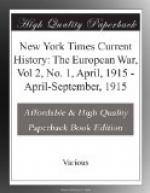South of the village, however, and close to the canal, the right of the Second Royal Munster Fusiliers fell back in conformity with the troops south of the canal, but after dark that regiment moved forward and occupied the old line.
During the course of the attack on Givenchy the enemy made five assaults on the salient at the northeast of the village about French Farm, but was repulsed every time with heavy loss.
6. On the morning of Jan. 29 attacks were made on the right of the First Corps, south of the canal in the neighborhood of La Bassee.
The enemy, (part of the Fourteenth German Corps,) after a severe shelling, made a violent attack with scaling ladders on the keep, also to the north and south of it. In the keep and on the north side the Sussex Regiment held the enemy off, inflicting on him serious losses. On the south side the hostile infantry succeeded in reaching the Northamptonshire Regiment’s trenches, but were immediately counter-attacked and all killed. Our artillery co-operated well with the infantry in repelling the attack.
In this action our casualties were inconsiderable, but the enemy lost severely, more than 200 of his killed alone being left in front of our position.
7. On Feb. 1 a fine piece of work was carried out by the Fourth Brigade in the neighborhood of Cuinchy.
Some of the Second Coldstream Guards were driven from their trenches at 2:30 A.M., but made a stand some twenty yards east of them in a position which they held till morning.
A counter-attack, launched at 3:15 A.M., by one company of the Irish Guards and half a company of the Second Coldstream Guards, proved unsuccessful, owing to heavy rifle fire from the east and south.
At 10:05 A.M., acting under orders of the First Division, a heavy bombardment was opened on the lost ground for ten minutes; and this was followed immediately by an assault by about fifty men of the Second Coldstream Guards with bayonets, led by Capt. A. Leigh Bennett, followed by thirty men of the Irish Guards, led by Second Lieut. F.F. Graham, also with bayonets. These were followed by a party of Royal Engineers with sand bags and wire.
All the ground which had been lost was brilliantly retaken, the Second Coldstream Guards also taking another German trench and capturing two machine guns.
Thirty-two prisoners fell into our hands.
The General Officer Commanding First Division describes the preparation by the artillery as “splendid, the high explosive shells dropping in the exact spot with absolute precision.”
In forwarding his report on this engagement, the General Officer Commanding First Army writes as follows:
Special credit is due—
(i) To Major Gen. Haking,
commanding First Division, for the
prompt manner in which
he arranged this counter-attack and for
the general plan of
action, which was crowned with success.




